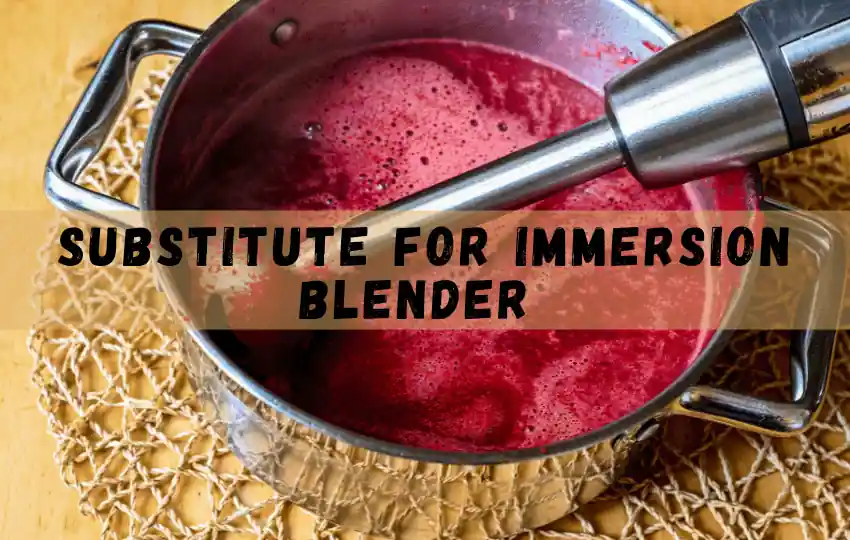Immersion blenders are essential tools for any home cook who enjoys making creamy soups, smoothies or sauces.
However, if you don’t have one or it isn’t available, there are several substitutes that could come in handy.
As an experienced home cook and chef, I have tried and tested these alternatives, so you don’t have to.
In this post, you’ll learn about 10 effective substitutes for immersion blender that you can try at home.
I have also included measurements and tips to make sure that you achieve the right consistency and texture in your dishes.
In short, " What can I use instead of an immersion blender?" Standard Blender, Food Processor, Handheld Mixer, Mortar and pestle, Whisk, Hand Blender Attachment, Fork or Potato Masher, Hand Mixer, Mason Jar, Sieve.
Best substitutes for immersion blender
1. Standard Blender
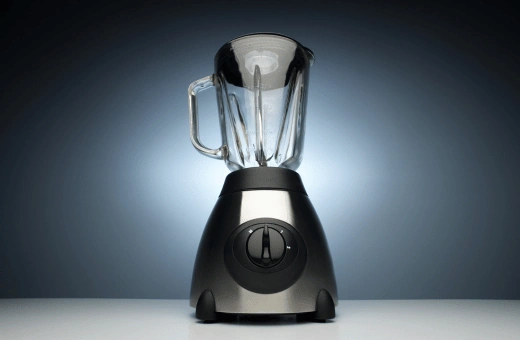
The most obvious substitute is a traditional blender, which is found in most homes. To use this substitute, you’ll need to transfer your ingredients into the blender and blend it.
The disadvantage of using a standard blender is that it’s challenging to achieve the smooth texture it gets when using an immersion blender, but if you’re patient, straining through a sieve will help with the texture.
2. Food Processor
Another good substitute is a food processor. Like with a standard blender, you’ll need to transfer your ingredients into the food processor and blend.
The food processor’s benefit is that it tends to create a thicker texture than a standard blender, making it perfect for recipes that require a chunkier consistency.
Start by blending the mixture on high or pulse for a few seconds, and then scrape down the sides with a spatula. Repeat this until you achieve the desired consistency.
You can add a small amount of liquid, if the mixture is too dry, such as broth or milk, to loosen it up. For best results, don’t fill the food processor to the brim to avoid spillage.
3. Handheld Mixer
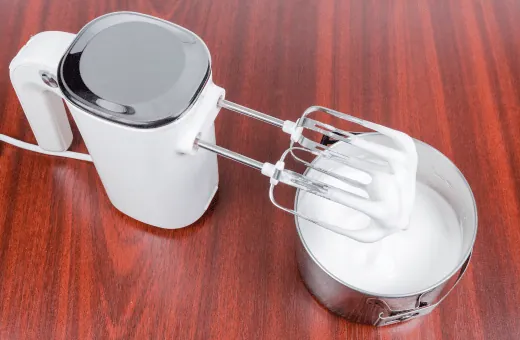
Handheld mixers are commonly used for baking, but they can also substitute immersion blenders. They work especially well for smaller batches of soups and sauces.
Simply blend ingredients until smooth.
4. Mortar and pestle
When it comes to small amounts of ingredients or spice mixes, a mortar and pestle can come in handy.
It’s an excellent substitute to get a rough blend. Remember that it can have a slightly labor-intensive process, but well worth it.
5. Whisk
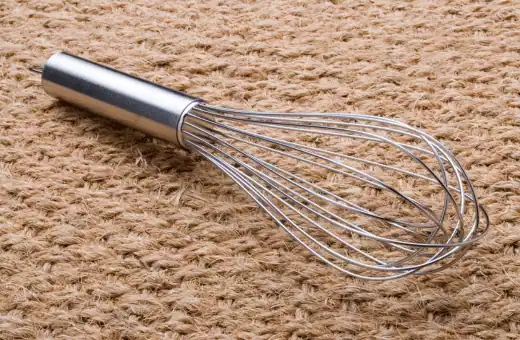
Like the mortar and pestle, using a whisk for blending is perfect for small amounts or even some mixing equipment, such as a jug or bowl.
It might take some more elbow grease, but it will do the trick.
6. Hand Blender Attachment
Did you know that some handheld mixers offer an attachment to blend ingredients? Some even come with a mini food processor attachment.
It provides a quick, easy switch from mixing to blending.
7. Fork or Potato Masher
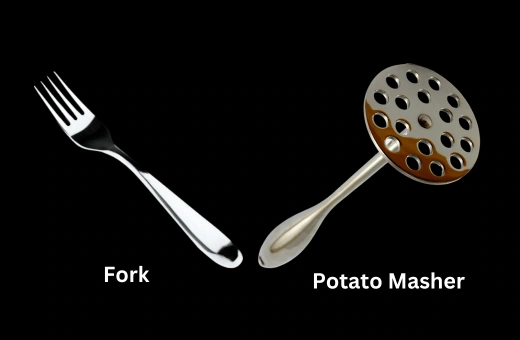
If all else fails, use a trusty fork or potato masher. While exceptionally labor-intensive, it’s a good temporary substitute for blending ingredients.
Try to get the ingredients into small manageable pieces and Mash or pulp into a smooth blend.
8. Hand Mixer
A hand mixer is ideal for whipping cream, eggs, and cake batters. To make a smoothie or sauce, use a large mixing bowl, and blend the mixture slowly while tilting the mixing bowl.
This helps to aerate the mixture and achieve a smooth texture.
Add a small amount of liquid if the mixture is too thick and continue to mix. However, take care not to over-mix and make the mixture too watery.
9. Mason Jar
A mason jar is a handy tool for blending small amounts of ingredients such as mayonnaise, pesto or salsa.
Put all the ingredients in the jar and blend them together with an immersion blender until well combined.
You can be used a regular blender to blend the ingredients in batches, but be sure not to overfill the blender jar.
10. Sieve

This is a useful technique for making small amounts of purees or baby food. Cook the vegetables until soft, and then use a fork to mash them into a pulp.
Pass the pulp through a sieve or fine-mesh colander to remove any lumps or fibrous bits. If required, add a small amount of liquid to make the puree smoother.
Laern more: Ideal Meat Mallet Substitutes That Tenderize the Meat
What to use instead of an immersion blender for soup?
Instead of an immersion blender, a standard blender can be used to make soups. It works by pureeing the soup ingredients in batches, which helps create a smooth and creamy consistency.
Additionally, a food processor or stand mixer with a whisk attachment can also be used to break down the soup ingredients.
These methods take longer and require more stirring than an immersion blender, but they will still help produce a delicious soup.
For the most satisfactory results, it is important not to over-blend the soup ingredients when using a standard blender or food processor.
Over-blending can make the soup too thin and watery.
Finally, a potato masher or handheld ricer can be used to create a chunky texture in soups without blending. This technique takes some time but adds an interesting and rustic look to any soup dish.
Discover more: latest Food processor Substitutes for your kitchen
Conclusion on substitute for immersion blender
In conclusion, immersion blenders are a fantastic kitchen tool, but they aren’t always the most accessible.
Sometimes, they might break before payday, or you have chosen not to splurge on one.
Fortunately, with the 10 alternatives above, you won’t have to worry about being stuck without a solution.
The best way to approach substitute immersion blenders is to look at the recipe and determine what substitute will work best for the specific blend.
Each alternative has its strengths and weaknesses, so consider selecting based on the texture you want; then you’re there! All the best in your home cooking endeavors!
Explore more: Meat Tenderizer Substitutes/Tenderize meat without mallet
FAQs on substitute for immersion blender
Q1. What is similar to an immersion blender?
A similar kitchen device to an immersion blender is a food processor. Which is an appliance that can be used to chop, grind, slice, and blend food. It features detachable blades and disks, allowing it to quickly switch from one task to the next. The blades and discs can easily be removed for cleaning or changing for another function.
Additionally, depending on the model and brand, many food processors can also knead the dough, shred cheese, and crush ice. With its versatile functions and long-lasting durability, a food processor is a great alternative kitchen tool to an immersion blender.
If you searching for an appliance that can do more than just blend, a stand mixer is a perfect solution. Stand mixers come in many sizes and are able to perform multiple tasks, such as mixing cake batter, kneading dough, and whipping cream or egg whites.
Maximum stand mixers come with attachments that allow them to function like a food processor, making them even more versatile. With the right bowl, lid and settings on your stand mixer, you can easily create delicious meals in no time.
Q2. Can you use a regular blender rather of an immersion blender?
Yes, you can use a regular blender rather of an immersion blender. A regular blender has its own advantages, as it is able to create many different textures depending on the speed and blending time that you choose to use.
You can blend up soups, sauces, smoothies, milkshakes and other blends with a regular blender. It also offers more bowl-size options and higher blade speed than an immersion blender. However, one downside of using a regular blender is that they tend to be louder than an immersion blender when blending ingredients.
Additionally, it is harder to clean a regular blender due to its larger size and the nooks and crannies the blades create. Ultimately, if you need versatility in texture and size options for your recipes, then a regular blender would be the better choice over an immersion blender.
Q3. How do you immersion blend without an immersion blender?
Without an immersion blender, blending foods can be done using either a traditional blender or a food processor. When using a traditional blender, it’s important to add liquid to the ingredients and begin with short bursts of low-speed blending.
This helps to protect the motor from getting overworked and ensures that all ingredients are properly blended. For best results, periodically scrape down the sides of the blender with a rubber spatula to ensure no chunks remain unblended.
When using a food processor, use the pulse setting for optimal blending. Again, adding liquid is important for preventing overworking the machine and ensuring proper mixing. It’s also necessary to be conscious of how much liquid is added since too much could lead to a soupy consistency.
Additionally, when using either a blender or food processor, it’s necessary to include some larger pieces of ingredients in order for there to be something to break up during blending in order for everything to mix together properly.
Q4. Can you substitute an immersion blender with a food processor?
No, an immersion blender and a food processor are two completely different tools. An immersion blender is used to blend and puree ingredients directly in a pot or bowl, while a food processor has more powerful blades that chop, slice, shred, mix and knead the dough.
They can both be used to create soups and sauces, but the results will be different depending on which tool you use.
For example, an immersion blender will create a very smooth soup, while a food processor might leave chunks of vegetables behind. It’s best to decide which tool works best for the dish you are trying to create before substituting one for the other.
Q5. Can I use a whisk instead of an immersion blender?
Yes, you can use a whisk instead of an immersion blender. A whisk is a handheld kitchen tool with a looped metal frame that has wires attached to it and is used for blending ingredients together. It can be used to mix batters, whip cream or egg whites, and even break up lumps in sauces or gravies.
However, it won’t provide the same level of blending power as an immersion blender. An immersion blender uses a spinning blade at the end of a stick-like device to blend ingredients quickly and easily into fine mixtures.
It requires less effort than using a whisk and will generally provide better results in terms of texture, consistency and smoothness. If you are looking for a homogenous texture, you may want to consider using an electric immersion blender instead of a manual whisk.
Q6. Can I use a hand mixer rather of an immersion blender for soup?
Yes, you can use a hand mixer rather of an immersion blender to make soup. A hand mixer is an effective tool for blending and puréeing ingredients. It works well for combining liquids, like stock or cream, in soups and sauces. The beaters on the mixer will help break down vegetables like carrots, onions, celery, potatoes, and tomatoes into a smooth consistency.
Additionally, some models come with attachments that allow users to quickly whisk eggs and whip cream for richer soups and sauces. Hand mixers are generally more affordable than immersion blenders and are easy to store away when not in use. However, keep in mind that they won’t work as well for very thick ingredients like smoothies and other pureed dishes that require more power than what a hand mixer can provide.

